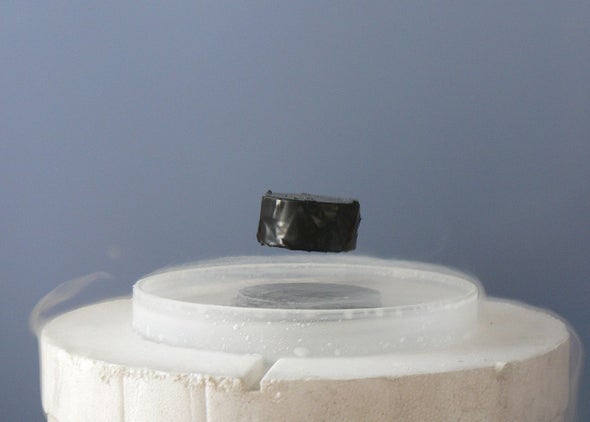Superconductivity
Superconductors are perfect conductors that can transmit electrical current without any resistance. This is due to the coherent behaviour of electrons, analogous to photons in a laser. One of the classic properties of superconductors is that they expel magnetic fields. This phenomenon, known as the Meissner effect, leads to spectacular effects such as magnet levitation (demonstrated below).


A magnet levitating above a superconductor cooled by liquid nitrogen. Credit: Mai-Linh Doan/Wikimedia Commons, CC BY-SA 3.0
Time-reversal symmetry breaking in superconductors
One class of superconductors, however, can form spontaneous magnetic fields in the superconducting state. This leads to breaking of time-reversal symmetry (TRS), which occurs when a physical system in a symmetric state ends up in an asymmetric state. These 'unconventional superconductors' are of particular interest due to their potential application in quantum computing and spintronics.
Using µSR and other techniques
Evidence of TRS breaking was initially detected in a few superconductors using the muon-spin rotation and relaxation (µSR) technique. µSR is a very sensitive probe for local magnetic field inside a sample, making zero-field µSR a key technique for investigating TRS breaking superconductors.
The optical Kerr effect can also be used to observe TRS breaking in superconductors. However, since these experiments are very challenging, it has been employed successfully in only a few superconductors. SQUID magnetometry can also be used to measure bulk magnetisation.
Collective outlook
As a result of their comprehensive review, the researchers suggest that one of the common properties of these TRS breaking superconductors is that their other behaviours are, surprisingly, conventional.
Looking to the future, they add that unconventional superconductors with TRS breaking offer additional degrees of freedom than conventional superconductors, and could therefore offer routes to novel qubit architectures for quantum computing.
Further Information
The full paper can be found online at DOI: 10.1088/1361-648X/abaa06
